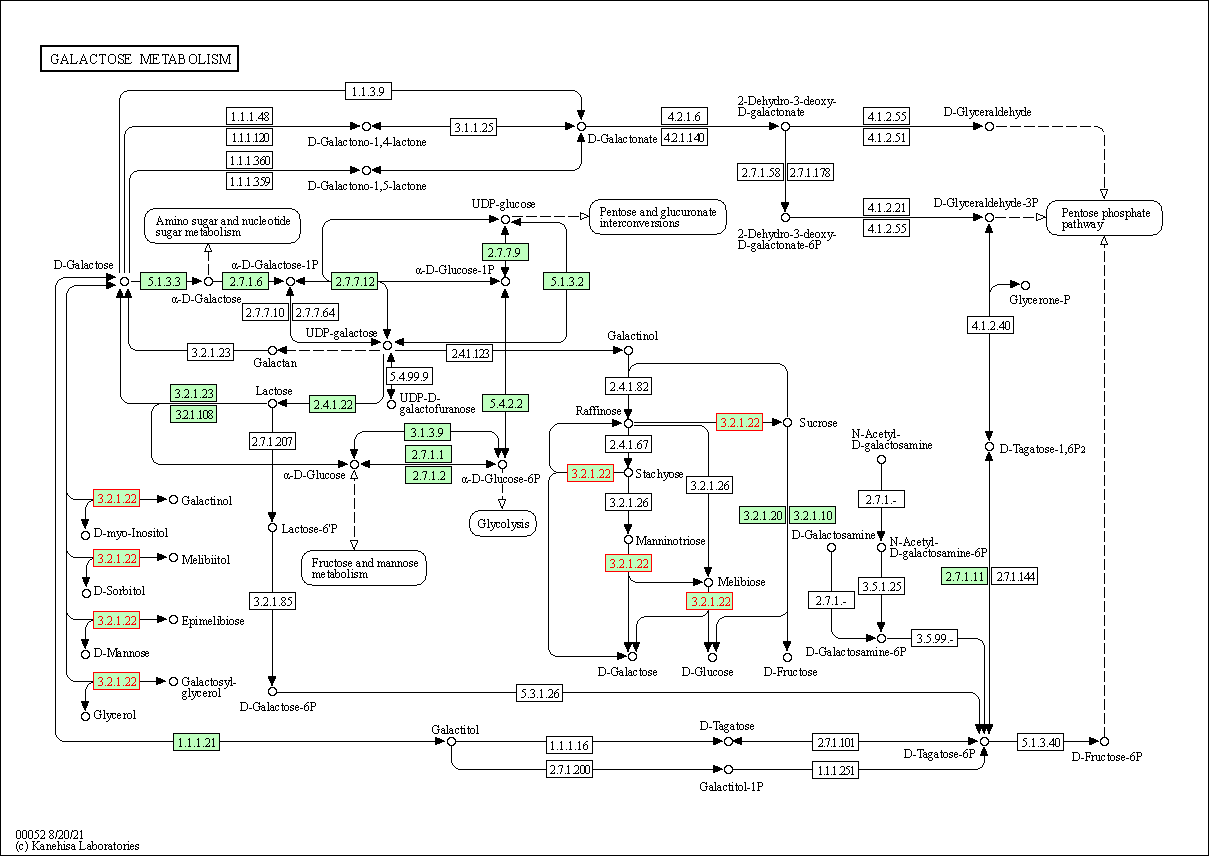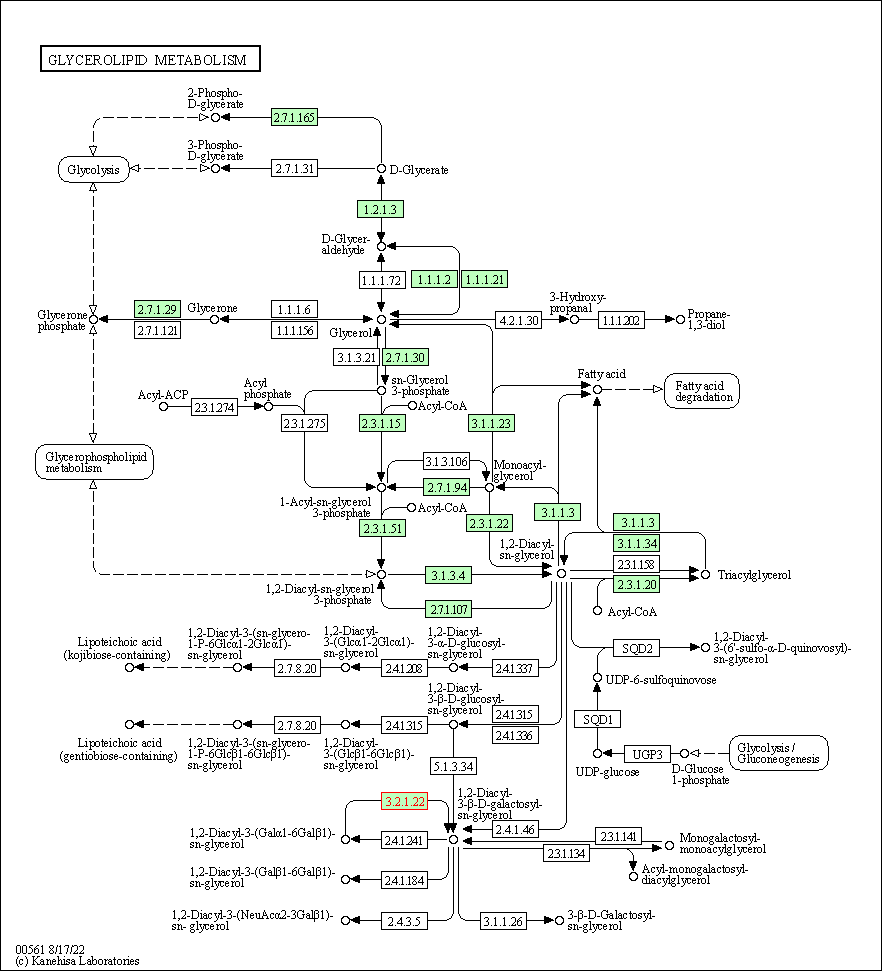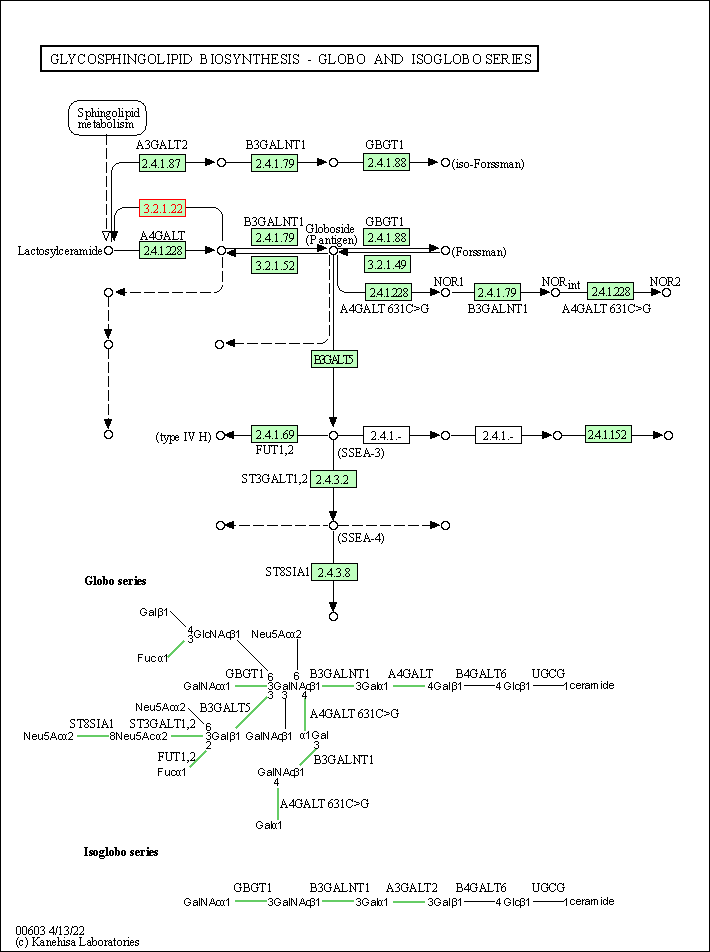Target Information
| Target General Information | Top | |||||
|---|---|---|---|---|---|---|
| Target ID |
T21678
(Former ID: TTDC00016)
|
|||||
| Target Name |
Alpha-galactosidase A (GLA)
|
|||||
| Synonyms |
Melibiase; INN=Agalsidase; Alpha-D-galactoside galactohydrolase; Alpha-D-galactosidase A
Click to Show/Hide
|
|||||
| Gene Name |
GLA
|
|||||
| Target Type |
Successful target
|
[1] | ||||
| Disease | [+] 1 Target-related Diseases | + | ||||
| 1 | Lysosomal disease [ICD-11: 5C56] | |||||
| Function |
A homodimeric glycoprotein that hydrolyses the terminal alpha-galactosyl moieties from glycolipids and glycoproteins. Predominantly hydrolyzes ceramide trihexoside, and can catalyze the hydrolysis of melibiose into galactose and glucose.
Click to Show/Hide
|
|||||
| BioChemical Class |
Glycosylase
|
|||||
| UniProt ID | ||||||
| EC Number |
EC 3.2.1.22
|
|||||
| Sequence |
MQLRNPELHLGCALALRFLALVSWDIPGARALDNGLARTPTMGWLHWERFMCNLDCQEEP
DSCISEKLFMEMAELMVSEGWKDAGYEYLCIDDCWMAPQRDSEGRLQADPQRFPHGIRQL ANYVHSKGLKLGIYADVGNKTCAGFPGSFGYYDIDAQTFADWGVDLLKFDGCYCDSLENL ADGYKHMSLALNRTGRSIVYSCEWPLYMWPFQKPNYTEIRQYCNHWRNFADIDDSWKSIK SILDWTSFNQERIVDVAGPGGWNDPDMLVIGNFGLSWNQQVTQMALWAIMAAPLFMSNDL RHISPQAKALLQDKDVIAINQDPLGKQGYQLRQGDNFEVWERPLSGLAWAVAMINRQEIG GPRSYTIAVASLGKGVACNPACFITQLLPVKRKLGFYEWTSRLRSHINPTGTVLLQLENT MQMSLKDLL Click to Show/Hide
|
|||||
| 3D Structure | Click to Show 3D Structure of This Target | PDB | ||||
| HIT2.0 ID | T05RYU | |||||
| Drugs and Modes of Action | Top | |||||
|---|---|---|---|---|---|---|
| Approved Drug(s) | [+] 2 Approved Drugs | + | ||||
| 1 | Migalastat | Drug Info | Approved | Fabry disease | [2] | |
| 2 | Pegunigalsidase alfa | Drug Info | Approved | Fabry disease | [3] | |
| Clinical Trial Drug(s) | [+] 4 Clinical Trial Drugs | + | ||||
| 1 | 4D-310 | Drug Info | Phase 1/2 | Fabry disease | [4] | |
| 2 | AVR-RD-01 | Drug Info | Phase 1/2 | Fabry disease | [5] | |
| 3 | isaralgagene civaparvovec | Drug Info | Phase 1/2 | Fabry disease | [6] | |
| 4 | ST-920 | Drug Info | Phase 1/2 | Fabry disease | [6] | |
| Mode of Action | [+] 2 Modes of Action | + | ||||
| Modulator | [+] 2 Modulator drugs | + | ||||
| 1 | Migalastat | Drug Info | [1], [7] | |||
| 2 | Pegunigalsidase alfa | Drug Info | [8] | |||
| Inhibitor | [+] 7 Inhibitor drugs | + | ||||
| 1 | (+)-5-deoxyadeenophorine | Drug Info | [12] | |||
| 2 | 2,5-dideoxy-2,5-imino-D-altritol | Drug Info | [13] | |||
| 3 | Alpha-D-Mannose | Drug Info | [14] | |||
| 4 | Beta-1-C-butenyl-1-deoxygalactonojirimycin | Drug Info | [13] | |||
| 5 | Beta-1-C-Butyl-1-deoxygalactonojirimycin | Drug Info | [13] | |||
| 6 | CALYSTEGINE B2 | Drug Info | [15] | |||
| 7 | Fucose | Drug Info | [14] | |||
| Cell-based Target Expression Variations | Top | |||||
|---|---|---|---|---|---|---|
| Cell-based Target Expression Variations | ||||||
| Drug Binding Sites of Target | Top | |||||
|---|---|---|---|---|---|---|
| Ligand Name: Levovist | Ligand Info | |||||
| Structure Description | Pharmacological Chaperoning in Human alpha-Galactosidase | PDB:3S5Z | ||||
| Method | X-ray diffraction | Resolution | 2.00 Å | Mutation | No | [16] |
| PDB Sequence |
LDNGLARTPT
41 MGWLHWERFM51 CNLDCQEEPD61 SCISEKLFME71 MAELMVSEGW81 KDAGYEYLCI 91 DDCWMAPQRD101 SEGRLQADPQ111 RFPHGIRQLA121 NYVHSKGLKL131 GIYADVGNKT 141 CAGFPGSFGY151 YDIDAQTFAD161 WGVDLLKFDG171 CYCDSLENLA181 DGYKHMSLAL 191 NRTGRSIVYS201 CEWPLYMWPF211 QKPNYTEIRQ221 YCNHWRNFAD231 IDDSWKSIKS 241 ILDWTSFNQE251 RIVDVAGPGG261 WNDPDMLVIG271 NFGLSWNQQV281 TQMALWAIMA 291 APLFMSNDLR301 HISPQAKALL311 QDKDVIAINQ321 DPLGKQGYQL331 RQGDNFEVWE 341 RPLSGLAWAV351 AMINRQEIGG361 PRSYTIAVAS371 LGKGVACNPA381 CFITQLLPVK 391 RKLGFYEWTS401 RLRSHINPTG411 TVLLQLENTM421
|
|||||
|
|
||||||
| Click to View More Binding Site Information of This Target and Ligand Pair | ||||||
| Ligand Name: Migalastat | Ligand Info | |||||
| Structure Description | Pharmacological Chaperoning in Human alpha-Galactosidase | PDB:3S5Y | ||||
| Method | X-ray diffraction | Resolution | 2.10 Å | Mutation | No | [16] |
| PDB Sequence |
LDNGLARTPT
41 MGWLHWERFM51 CNLDCQEEPD61 SCISEKLFME71 MAELMVSEGW81 KDAGYEYLCI 91 DDCWMAPQRD101 SEGRLQADPQ111 RFPHGIRQLA121 NYVHSKGLKL131 GIYADVGNKT 141 CAGFPGSFGY151 YDIDAQTFAD161 WGVDLLKFDG171 CYCDSLENLA181 DGYKHMSLAL 191 NRTGRSIVYS201 CEWPLYMWPF211 QKPNYTEIRQ221 YCNHWRNFAD231 IDDSWKSIKS 241 ILDWTSFNQE251 RIVDVAGPGG261 WNDPDMLVIG271 NFGLSWNQQV281 TQMALWAIMA 291 APLFMSNDLR301 HISPQAKALL311 QDKDVIAINQ321 DPLGKQGYQL331 RQGDNFEVWE 341 RPLSGLAWAV351 AMINRQEIGG361 PRSYTIAVAS371 LGKGVACNPA381 CFITQLLPVK 391 RKLGFYEWTS401 RLRSHINPTG411 TVLLQLENTM421
|
|||||
|
|
||||||
| Click to View More Binding Site Information of This Target and Ligand Pair | ||||||
| Click to View More Binding Site Information of This Target with Different Ligands | ||||||
| Different Human System Profiles of Target | Top |
|---|---|
|
Human Similarity Proteins
of target is determined by comparing the sequence similarity of all human proteins with the target based on BLAST. The similarity proteins for a target are defined as the proteins with E-value < 0.005 and outside the protein families of the target.
A target that has fewer human similarity proteins outside its family is commonly regarded to possess a greater capacity to avoid undesired interactions and thus increase the possibility of finding successful drugs
(Brief Bioinform, 21: 649-662, 2020).
Human Tissue Distribution
of target is determined from a proteomics study that quantified more than 12,000 genes across 32 normal human tissues. Tissue Specificity (TS) score was used to define the enrichment of target across tissues.
The distribution of targets among different tissues or organs need to be taken into consideration when assessing the target druggability, as it is generally accepted that the wider the target distribution, the greater the concern over potential adverse effects
(Nat Rev Drug Discov, 20: 64-81, 2021).
Human Pathway Affiliation
of target is determined by the life-essential pathways provided on KEGG database. The target-affiliated pathways were defined based on the following two criteria (a) the pathways of the studied target should be life-essential for both healthy individuals and patients, and (b) the studied target should occupy an upstream position in the pathways and therefore had the ability to regulate biological function.
Targets involved in a fewer pathways have greater likelihood to be successfully developed, while those associated with more human pathways increase the chance of undesirable interferences with other human processes
(Pharmacol Rev, 58: 259-279, 2006).
Biological Network Descriptors
of target is determined based on a human protein-protein interactions (PPI) network consisting of 9,309 proteins and 52,713 PPIs, which were with a high confidence score of ≥ 0.95 collected from STRING database.
The network properties of targets based on protein-protein interactions (PPIs) have been widely adopted for the assessment of target’s druggability. Proteins with high node degree tend to have a high impact on network function through multiple interactions, while proteins with high betweenness centrality are regarded to be central for communication in interaction networks and regulate the flow of signaling information
(Front Pharmacol, 9, 1245, 2018;
Curr Opin Struct Biol. 44:134-142, 2017).
Human Similarity Proteins
Human Tissue Distribution
Human Pathway Affiliation
Biological Network Descriptors
|
|
|
There is no similarity protein (E value < 0.005) for this target
|
|
Note:
If a protein has TS (tissue specficity) scores at least in one tissue >= 2.5, this protein is called tissue-enriched (including tissue-enriched-but-not-specific and tissue-specific). In the plots, the vertical lines are at thresholds 2.5 and 4.
|





| KEGG Pathway | Pathway ID | Affiliated Target | Pathway Map |
|---|---|---|---|
| Galactose metabolism | hsa00052 | Affiliated Target |

|
| Class: Metabolism => Carbohydrate metabolism | Pathway Hierarchy | ||
| Glycerolipid metabolism | hsa00561 | Affiliated Target |

|
| Class: Metabolism => Lipid metabolism | Pathway Hierarchy | ||
| Sphingolipid metabolism | hsa00600 | Affiliated Target |

|
| Class: Metabolism => Lipid metabolism | Pathway Hierarchy | ||
| Glycosphingolipid biosynthesis - globo and isoglobo series | hsa00603 | Affiliated Target |

|
| Class: Metabolism => Glycan biosynthesis and metabolism | Pathway Hierarchy | ||
| Lysosome | hsa04142 | Affiliated Target |

|
| Class: Cellular Processes => Transport and catabolism | Pathway Hierarchy | ||
| Degree | 8 | Degree centrality | 8.59E-04 | Betweenness centrality | 1.14E-03 |
|---|---|---|---|---|---|
| Closeness centrality | 1.38E-01 | Radiality | 1.15E+01 | Clustering coefficient | 1.07E-01 |
| Neighborhood connectivity | 4.13E+00 | Topological coefficient | 2.06E-01 | Eccentricity | 13 |
| Download | Click to Download the Full PPI Network of This Target | ||||
| Chemical Structure based Activity Landscape of Target | Top |
|---|---|
| Drug Property Profile of Target | Top | |
|---|---|---|
| (1) Molecular Weight (mw) based Drug Clustering | (2) Octanol/Water Partition Coefficient (xlogp) based Drug Clustering | |
|
|
||
| (3) Hydrogen Bond Donor Count (hbonddonor) based Drug Clustering | (4) Hydrogen Bond Acceptor Count (hbondacc) based Drug Clustering | |
|
|
||
| (5) Rotatable Bond Count (rotbonds) based Drug Clustering | (6) Topological Polar Surface Area (polararea) based Drug Clustering | |
|
|
||
| "RO5" indicates the cutoff set by lipinski's rule of five; "D123AB" colored in GREEN denotes the no violation of any cutoff in lipinski's rule of five; "D123AB" colored in PURPLE refers to the violation of only one cutoff in lipinski's rule of five; "D123AB" colored in BLACK represents the violation of more than one cutoffs in lipinski's rule of five | ||
| Co-Targets | Top | |||||
|---|---|---|---|---|---|---|
| Co-Targets | ||||||
| Target Poor or Non Binders | Top | |||||
|---|---|---|---|---|---|---|
| Target Poor or Non Binders | ||||||
| Target Affiliated Biological Pathways | Top | |||||
|---|---|---|---|---|---|---|
| KEGG Pathway | [+] 5 KEGG Pathways | + | ||||
| 1 | Galactose metabolism | |||||
| 2 | Glycerolipid metabolism | |||||
| 3 | Sphingolipid metabolism | |||||
| 4 | Glycosphingolipid biosynthesis - globo series | |||||
| 5 | Lysosome | |||||
| Pathwhiz Pathway | [+] 2 Pathwhiz Pathways | + | ||||
| 1 | Sphingolipid Metabolism | |||||
| 2 | Galactose Metabolism | |||||
| Reactome | [+] 1 Reactome Pathways | + | ||||
| 1 | Glycosphingolipid metabolism | |||||
| WikiPathways | [+] 1 WikiPathways | + | ||||
| 1 | Sphingolipid metabolism | |||||
| Target-Related Models and Studies | Top | |||||
|---|---|---|---|---|---|---|
| Target Validation | ||||||
| References | Top | |||||
|---|---|---|---|---|---|---|
| REF 1 | AT-1001: a high-affinity alpha3beta4 nAChR ligand with novel nicotine-suppressive pharmacology. Br J Pharmacol. 2015 Apr;172(7):1834-45. | |||||
| REF 2 | 2018 FDA drug approvals.Nat Rev Drug Discov. 2019 Feb;18(2):85-89. | |||||
| REF 3 | FDA Approved Drug Products from FDA Official Website. 2023. Application Number: 761161. | |||||
| REF 4 | ClinicalTrials.gov (NCT04519749) An Open-label, Phase 1/2 Trial of Gene Therapy 4D-310 in Adults With Fabry Disease. U.S.National Institutes of Health. | |||||
| REF 5 | ClinicalTrials.gov (NCT03454893) FAB- GT Open-Label, Study Of Efficacy and Safety Of AVR-RD-01 for Treatment -Naive Subjects With Classic Fabry Disease. U.S. National Institutes of Health. | |||||
| REF 6 | ClinicalTrials.gov (NCT04046224) A Phase I/II, Multicenter, Open-Label, Single-Dose, Dose-Ranging Study to Assess the Safety and Tolerability of ST-920, an AAV2/6 Human Alpha Galactosidase A Gene Therapy, in Subjects With Fabry Disease (STAAR). U.S.National Institutes of Health. | |||||
| REF 7 | The pharmacological chaperone 1-deoxygalactonojirimycin increases alpha-galactosidase A levels in Fabry patient cell lines. J Inherit Metab Dis. 2009 Jun;32(3):424-40. | |||||
| REF 8 | Characterization of a chemically modified plant cell culture expressed human alpha-Galactosidase-A enzyme for treatment of Fabry disease. Mol Genet Metab. 2015 Feb;114(2):259-67. | |||||
| REF 9 | Clinical pipeline report, company report or official report of 4D Molecular Therapeutics | |||||
| REF 10 | Clinical pipeline report, company report or official report of Avrobio. | |||||
| REF 11 | AAV2/6 Gene Therapy in a Murine Model of Fabry Disease Results in Supraphysiological Enzyme Activity and Effective Substrate Reduction. Mol Ther Methods Clin Dev. 2020 Jul 9;18:607-619. | |||||
| REF 12 | Flexible synthesis and biological evaluation of novel 5-deoxyadenophorine analogues. Bioorg Med Chem Lett. 2006 Jun 15;16(12):3262-7. | |||||
| REF 13 | 2,5-Dideoxy-2,5-imino-d-altritol as a new class of pharmacological chaperone for Fabry disease. Bioorg Med Chem. 2010 Jun 1;18(11):3790-4. | |||||
| REF 14 | How many drug targets are there Nat Rev Drug Discov. 2006 Dec;5(12):993-6. | |||||
| REF 15 | Identification of the glycosidase inhibitors swainsonine and calystegine B2 in Weir vine (Ipomoea sp. Q6 [aff. calobra]) and correlation with toxicity. J Nat Prod. 1995 Jun;58(6):878-86. | |||||
| REF 16 | The molecular basis of pharmacological chaperoning in human Alpha-galactosidase. Chem Biol. 2011 Dec 23;18(12):1521-6. | |||||
If You Find Any Error in Data or Bug in Web Service, Please Kindly Report It to Dr. Zhou and Dr. Zhang.

